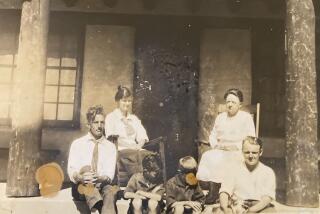Discovery of ‘Lost’ Peruvian City Casts New Light on Mysterious Lines : Archeology: Nasca people created enormous designs in the desert. These odd masterpieces rank among civilization’s great puzzles.
- Share via
Discovery of a 2,000-year-old lost city in southern Peru is casting new light on one of the world’s great mysteries, the Nasca lines.
Farmers and artists, priests and warriors created the lines. They built temples and pyramids and underground aqueducts, created exquisite pottery--and cut off the heads of their enemies for trophies.
But the Nasca people are best known today for the fabulous designs they scratched in the rock-strewn desert: enormous triangles, trapezoids and spirals covering acres of land as barren as moonscapes. Their elegantly stylized animals are so immense that they can best be seen from aircraft.
Objects of speculation for decades, these odd masterpieces rank among civilization’s great puzzles, alongside the monoliths of Stonehenge in England and the massive stone heads of Easter Island in the South Pacific.
Were the Nasca lines intended as landing strips for ancient astronauts? Were they sky maps, laid out by astrologer-priests to help forecast the future?
Archeological discoveries in the last two years, while not completely solving the riddle of the lines, are revealing a more believable picture of their creators. While the desert wizards of Nasca may not have had supernatural powers, they clearly were masters of their own universe.
“This was absolutely a great civilization,” says archeologist Helaine I. Silverman of the University of Illinois. “In many ways they were geniuses.”
Silverman has discovered remains of what she believes to be the metropolis that formed the major population center of the Nasca people.
She has named it Site 165, or Ventilla, for a tiny modern-day settlement nearby. The ancient city lies at the base of the elevated desert plain containing most of the enigmatic lines.
Although the site is now largely covered by a scrubby, dried-out forest, its broad outlines once were visible from the air. Silverman originally identified it by closely examining aerial photographs.
“I’m sure this is the capital,” Silverman says. “What I’m hoping is that the short-lived agriculture between 1947 and 1970 did just superficial damage to the site, and that if we dig, we’ll be able to see a good part of the city with all its architecture, and trace its history.”
Near Ventilla, and connected to it by one of the strange desert lines, lies another major site: Cahuachi, thought by archeologists to be the main population center of the ancient Nasca people before Silverman’s discovery of Ventilla.
Silverman’s research shows that Cahuachi was never inhabited on a permanent basis, but instead seems to have been a great holy city. Periodically, people throughout southern coastal Peru may have suspended their more or less constant tribal warfare long enough to allow pilgrimages to Cahuachi.
The Nasca culture dominated the region between 200 BC and AD 600. At about the time ideas of such Greek scholars as Euclid, Ptolemy and Archimedes were laying foundations of Western science, a vigorous, creative people appeared in a series of 10 fertile valleys feeding into Peru’s Rio Grande de Nasca.
There is no evidence of an empire. Scientists like Silverman believe the culture consisted of a loose association of family clans. Each may have had an animal emblem, which could explain the figures drawn on the desert.
Warfare over land and water was a way of life.
“I don’t see it so much as economic, like the control of trade routes,” says Silverman. “It was literally a matter of survival. It was a landscape of internecine warfare, hit-and-run raiding.”
Silverman’s survey data show that the biggest and most elaborate lines were drawn during an early period of the culture, when the clans were more united through their religious pilgrimages to Cahuachi. Worship there may have involved trooping out to the nearby desert and dancing along lines previously marked by priests.
“They were wonderful feats, but by no means do we have to call in the notion of ancient astronomers and great mathematicians,” says Silverman, whose work has been supported in part by the National Geographic Society.
She has no doubt that the figures were drawn for the benefit of the gods: the bigger the design, in all likelihood the bigger the group involved and the greater the god it was intended to please.
“Maybe the priests were in charge of the activity,” she says. “I think it’s reasonable to think of a leader saying, ‘OK, guys, it’s time to get out to the pampa.’ Everybody drinks a lot of beer, which is probably why there’s so much broken pottery on the pampa, and basically everybody gets blasted as they lay out these terrific figures and lines.”
More to Read
Sign up for Essential California
The most important California stories and recommendations in your inbox every morning.
You may occasionally receive promotional content from the Los Angeles Times.









